Description of the variety
LE-Odalisque is a breeding product of the famous Ukrainian scientist Elena Lebetskaya. Absolutely all of her brainchildren are very popular, not only in the CIS countries, but also far beyond their borders. It was she who created the world's only Lyon’s Early Spring variety, a distinctive feature of which are huge snow-white flowers. Her violets have repeatedly received prizes at various exhibitions and competitions.
LE-Odalisque is a Saintpaulia with flowers of a pale pink hue. The central part of the bud is distinguished by a more intense color and looks like a dark eye, which attracts the eye to the depth of the flower, thereby giving it a special charm. As the plant matures, its color changes: it becomes darker, almost coral.
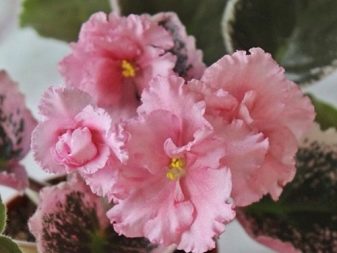

The blossoming flowers are rather large (as a rule, not less than 6-7 cm in diameter). The petals are neat, have the same size, wavy shape with smooth transitions. The edges are openwork, fringed. This gives the flower a special splendor and decorative effect. The flower shape with wide-open petals is called "star".
Peduncles are long and strong, due to which the flower rises above the leafy rosettes, as if crowning them. The rosette itself is quite neat, even, round in shape. The size is 25-35 cm. The petioles are shortened and thickened, so the rosette seems to be dense. The leaf plates are saturated, dark green, heart-shaped, slightly curved upwards. Light yellow edging trims the edges. The marks chaotically located on the sheet plates have the same shade.
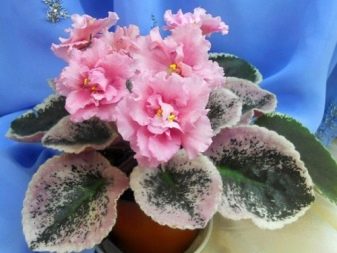

LE-Odalisque is a very showy plant with velvety leaves and large, delicate inflorescences. These violets have won the love of flower growers not only for their decorativeness, but also for their exceptional unpretentiousness. Nevertheless, if you want your green "pet" to delight you with its flowering as long as possible, you should adhere to certain rules of caring for it.
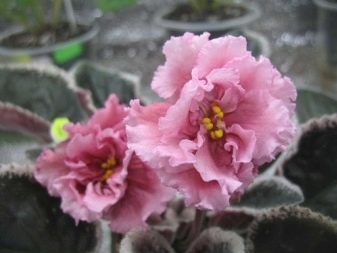
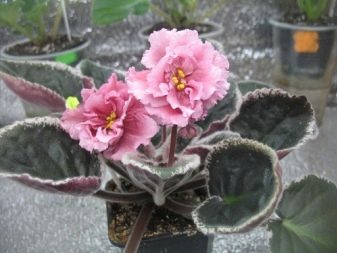
Lighting
Like any other Saintpaulia, LE-Odalisque prefers diffused lighting. Therefore, it is better to install the flower on a windowsill located on the east or west side. Another good option is to put the flower on a table near the window. This plant categorically does not tolerate direct sunlight, so if you intend to place a violet on the south or southeast window, then it should be shaded a little. Most often, for this purpose, a reflective film is glued or the glass is covered with thin paper.
From time to time, the violet pot must be rotated around its axis. If this is not done, then the sheet plates will stretch in only one direction, which will significantly worsen the appearance of the outlet.
The flower requires long daylight hours. If you do not provide Saintpaulia with the required amount of light, the plant will produce very few flowers or stop producing flower stalks altogether. For full-fledged growth and flowering, it needs illumination for 12-14 hours, therefore, in winter, it needs additional illumination with special fluorescent or LED lamps.
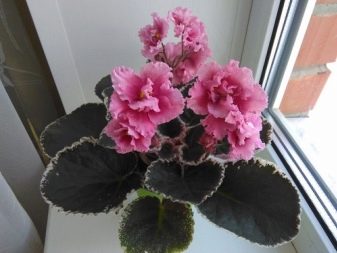
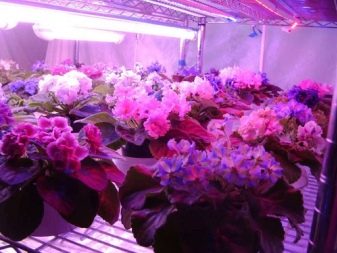
Temperature
Saintpaulias prefer a moderate heat background. The optimum temperature for a flower is 20-23 degrees. At low or, conversely, higher temperatures, the plant stops blooming altogether.
It should be noted that LE-Odalisque does not tolerate cold. From low temperatures, the roots begin to rot, as the plant does not receive enough nutrients. To prevent the death of the flower in the winter, a Styrofoam plate should be placed under the pot. It will protect the soil and, accordingly, the roots from freezing during the cold period.
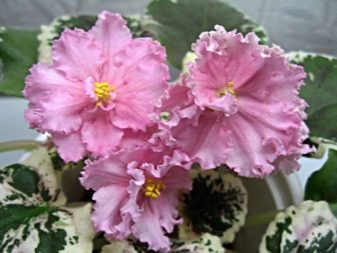
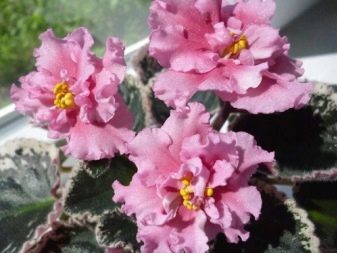
Watering
Saintpaulias need regular but moderate watering.It is produced as the soil dries up about 2-3 times every 7 days. It is best to pour water into a sump. The moisture remaining in the saucer should be drained after 15-20 minutes, otherwise the roots will begin to rot. For external irrigation, it is worth using a watering can with a long, thin spout so that the liquid falls strictly under the root, without affecting the velvet leaves and the growth point.

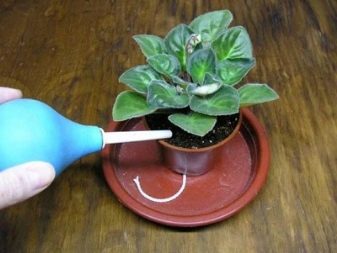
Air humidity
Saintpaulias prefer well humidified air, but leaves should not be sprayed. The best option is to turn on a humidifier for several hours a day or spray the space at a distance of 1-1.5 meters from the flower from a spray bottle.

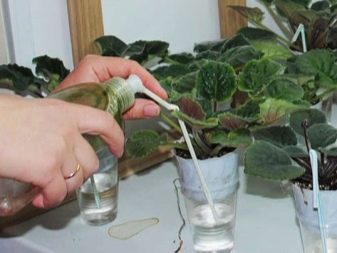
Fertilizer
Once or twice a month from February to October, the plant needs fertilizing. To do this, it is best to use ready-made store-bought complex preparations created specifically for Saintpaulias.
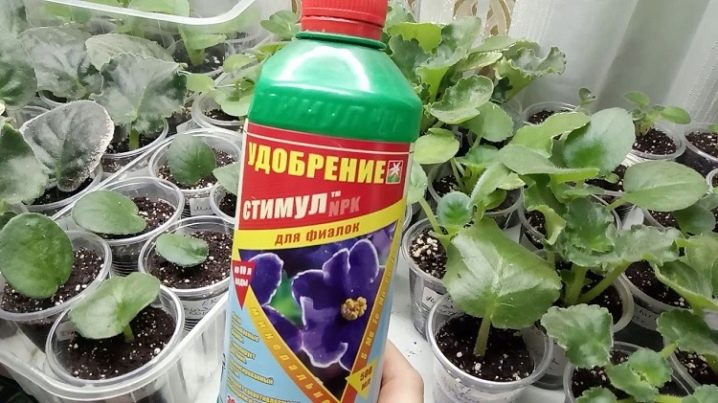
Features of caring for a violet Gold of the Scythians
Violets Gold of the Scythians (AB) and Gold of the Scythians (LE) are almost identical in care:
The most important rule for maintaining color saturation and the appearance of the border is observance of the temperature regime. For any Saintpaulia, temperatures above 30 degrees are destructive.
As for varietal specimens, it is best to maintain a temperature of 17 to 23 degrees during the laying of flower stalks. Scythian gold in cooler conditions often displays a green border.
Attention! The myth that violets love shade has killed a lot of plants. Violet lighting must be right
Saintpaulias love bright, but diffused light. Lack of lighting leads to a lack of flowering, stretching the leaves up. And at the same time, too intense sun can burn the leaves. Therefore, it is best to shade the southern and southeastern windows with blinds or glue special paper on the windows.
In winter, it is important to organize the backlight
The violet lighting must be correct. Saintpaulias love bright, but diffused light. Lack of lighting leads to a lack of flowering, stretching the leaves up. And at the same time, too intense sun can burn the leaves. Therefore, it is best to shade the southern and southeastern windows with blinds or glue special paper on the windows.
In winter, it is important to organize the backlight
Violets of these varieties do not like over-watering, as well as severe drought. The soil is watered as the top layer dries up per centimeter. The water should be settled and not cold. As for wick irrigation, the requirements are similar.
Important! Spraying on flowers or leaves is not required and can even ruin the plant. But periodic bathing removes dust from outlets.
You can wash the violet right under the tap by gently tilting the leaves. After that, the pot is left in a draft-free place to dry for a couple of hours. When bathing, cover the ground with foil
But periodic bathing removes dust from the outlets. You can wash the violet right under the tap by gently tilting the leaves. After that, the pot is left in a draft-free place to dry for a couple of hours. When bathing, cover the ground with foil.
High humidity, contrary to popular myth, violets are not needed at all. Moreover, in low temperatures, excessive moisture can lead to rot and mold. During the heating season, if dry tips begin to appear on the leaves, it is best to use a moisturizer (it is useful for both flowers and people).
Soil is the most important rule in the successful cultivation of the LE Zlato Scythian flower. Plain earth will not work as it gets wet quickly
The ideal solution is high-moor peat (40 percent) and ripper (perlite, foam balls, vermiculite).
Any varieties of Saintpaulias require frequent fertilization and soil changes. With a lack of nutrients, the violet Zlato Scythians loses the rich color of the leaves, does not bloom, or the buds become smaller.
Observing all the rules, you can achieve perfect nodding flowering.
Blooms most often in the second half of summer and early autumn.The flowers are large, bright color appears as they dissolve. In hot conditions, the color may turn completely pink with a small patch of yellow inside.
For reference! By the way, the AB Zoloto Scythian variety also loses most of its yellow color in the heat, acquiring pink. Accordingly, no border will be visible.
Saintpaulia can be propagated in three ways:
- Seeds. The variant is most often used by breeders.
- Leafy cuttings.
- Peduncles (in the case of chimeras).
The most common option is to take a leafy cutting. It should be cut off with a sharp blade (wipe with alcohol), the sheet is needed from the second row. It is necessary to choose copies without spots and defects.
Next, you need to either put the cutting in water until the roots appear (then place it in the ground), or immediately root it in the ground.
To do this, pour a mixture of perlite and peat in a ratio of 60 to 40 into a small plastic glass. Place the sheet to a depth of one centimeter and strengthen it in the ground. After that, it is better to place the stalk in a greenhouse - here the processes will go faster.
Rooting a violet leaf
After about 2 weeks, the leaf will take root, and after a month, children. The latter should be planted as soon as at least 4 sheets of at least 2 centimeters in size have grown.
Improper planting of violet babies
Violet Odalisque: growing and care
Violet Odalisque: photo of the variety
The amount of light.
Variety Odalisque violet is an unpretentious plant, but, despite this, it must be well looked after, and also provided with good lighting, correct temperature and humidity. These criteria are very important for the normal functioning of the plant. Otherwise, the plant will wilt, and may also completely stop its flowering process.
For a violet of the LE Odalisque variety, a good and diffused light is perfect, therefore, the plant should be placed on the windowsills of the east or west. It is worth limiting the plant from direct rays, as they have a detrimental effect on the plant. They act very aggressively on the leaves and burn them, leaving burns that are difficult to heal. To avoid various burns, the plant is rearranged for a while to another place or covered with cloth.
Violet Odalisque can be placed not only on the windowsill, it can also be installed on a table or chair, which is located near the windows.
Sometimes the flower must be turned over so that each side of the flower is in the sun and thus evenly develops. It will also make the plant look healthier and also more attractive. Otherwise, one side of the flower will be healthy and the other will wither. It is also fraught with uneven growth of leaves and stems.
The amount of light should be quite voluminous, on average, a flower needs about 13 hours of light. In case of insufficient lighting, you should use ordinary lamps that are installed above the plants.
What should be the temperature?
The right temperature is the next most important factor, as it affects the flowering process, its quality and duration. For violets LE Odalisque, an average temperature of 22 degrees is suitable
If it is less or more, then the flower will stop developing and growing.
The violet variety Odalisque cannot tolerate low temperatures, the stem begins to freeze and the plant eventually dies. Therefore, the temperature must be carefully monitored so as not to lose the plant. You can cover the pot with polystyrene foam, which will slightly protect the root system from frost, especially in the winter.
But at the same time, the temperature should not rise above 27 degrees. Such a temperature will also have a bad effect on the plant, it will begin to dry out, moisture will evaporate, the plant will look sluggish and sickly.
Violet LE Odalisque: photo of the variety
Watering.
Watering should be done about twice a week. The frequency of watering depends only on the condition of the soil; with a slight drying out, it is necessary to immediately apply water.The plant does not tolerate drought well and cannot be without water for a long time. In its absence, the flower dries up. Excessive moisture is also detrimental to the flower, like drought. With a lot of watering, rot begins to develop in the root system, affecting some areas. This leads the plant to death.
The amount of moisture in the air.
Odalisca violets are good for increased moisture, but it should be borne in mind that the spraying method cannot be used. The best option is a herbal moisturizer, available at specialty stores.
Top dressing.
Top dressing of violets LE Odalisque is applied to the soil for a whole year, about 1 time in 60 days. Gardeners recommend using a complex fertilizer containing all the necessary trace elements. You can also add wood ash, separately phosphorus or nitrogen fertilizing.
Features of home care
Plant care procedures are standard, although there are several nuances.
Watering rules
The outlet at LE Odalisque does not have a strong density, so watering can be carried out as usual through a watering can with a narrow spout. It should be remembered that the liquid should not get on the foliage and stems. The water must definitely stand so that all the main impurities settle. Its temperature should correspond to the room temperature.

Top dressing
Top dressing is preferable to carry out root, alternating organic and mineral complexes.
For example:
- "Stimovit" (organic preparation) - the solution is prepared in a proportion of 25 ml / 1 l of water, used 1-2 times a month;
- "Master" (mineral complex) - watering is carried out with a solution in a concentration of 5 ml / 1 l of water, 1-2 times a month.
Both complexes increase the immunity of the violet to diseases and insect attacks. Thanks to balanced compositions, the plant maintains decorative foliage, blooms luxuriantly and for a long time.
Pruning
The pruning procedure itself is not for Saintpaulias, the rosette is rejuvenated by removing the lower leaves when they become too large. If any leaf plates have dried out, it is also advisable to remove them yellowed.

Transfer
The plant needs a transplant annually, in the spring: as it grows, the bush exposes the base of the outlet, which does not look aesthetically pleasing. The Saintpaulia pot is selected 2 cm larger than the previous one. If transplanted into a container that is too spacious, the plant will begin to grow roots instead of forming peduncles.
The primer can be purchased for violets, for example "Laflora". It must be diluted with rotten compost (10th part). The amount of organic additive should not be increased, since the variegation may disappear due to the excess of nitrogen. In addition, the acidity of the soil will increase, which is also not desirable for LE-Odalisque.
Transplant technology:
- The pot should be watered a couple of hours before the procedure.
- When the soil dries out a little, carefully dump the flower, being careful not to damage the roots.
- The roots are examined, cut too long and treated with activated carbon powder.
- 2-3 cm of drainage is placed on the bottom of the new container, a pile of earth is poured.
- Place a Saintpaulia bush and pour the soil neatly along the edges of the pot.
- The center of the outlet with the growth point should not be buried, otherwise it will begin to rot.
- After transplanting, the plant must be placed in a dark place for a couple of hours.
- Then pour over.
- The first feeding is not earlier than after 2 weeks.
Varieties of violets with names, photos and color separation
According to the color of the petals, saintpaulias, or home violets, are divided into monochromatic and painted in two or more colors.
Typical varieties of one-color indoor violets:
Saintpaulia Blue Tail Fly (J. Dates breeder)
blue violet with bright "wasp" flowers with upper tubular and elongated lower petals. The fleecy leaves of the home violet, which make up the rosette, are rolled into "little bags".
Violet Gillian (Gillian) (breeder D. Ferguson)
has white large double flowers, resembling a carnation in shape.The rosette of this variety of indoor violet consists of rounded "quilted" green leaves and can reach 40 cm in size.
Violet petals can be in the form of eyes located in the center, or fingers. These colors include the following varieties:
Violet Rob's Penny Ante (breeder R. Robinson)
it is a beautiful violet variety with semi-double, white, bell-like flowers with a dark blue eye in the center. The size of this variety of violets does not exceed 2.5 cm. A compact rosette of about 9 cm consists of even light green leaves.
Violet Pink Sensation (bred by Lyndon Lyon Greenhouses / Sorano)
semi-double white violet, the flowers of which look like stars. Large spots of pale pink color are clearly visible in the center of the petals. The rosette is made up of variegated white-green leaves.
Home violet petals may have a border that runs along the edge. Its width and color can be different and even fancy:
Violet Natalia's Extravagante (Natalis Estravagante) (breeder N. Pineault)
variety of home violets with white-pink lacy flowers and a border, the tone of which can be green, chocolate or pink. The rosette is assembled from green leaf plates with marginal variegation of pink-white color.
Saintpaulia AE Modern Talking (breeder E.A. Arkhipov)
variety of violets with white semi-double frilly flowers "pansies" and a border of pink-blue-violet hue. This is a standard sized bush of this room violet with light green flat foliage.
Indoor violet petals can have stripes of different colors, diverging from the center of the petal to its edges. This is a violet chimera, the varieties of which are presented below:
Violet Chimera Chain Reaction (breeder S. Sorano)
a variety of indoor violets, over the standard green rosette of which there are large pink flowers with a light lilac stripe running along the center of the petal. The entire surface of the flower petals is strewn with blotches of lilac color.
Violet chimera Queen Sabrina (Queen Sabrina) (breeder P. Sorano)
has double flowers of coral color and thin purple stripes on each petal. The rosette is rolled up from small dark green leaves.
The petals of home violets come with spraying or streaks of various colors and shades:
Saintpaulia EK-Rain Music (breeder E.V. Korshunova) is a variety of the uzambar violet with large creamy, star-shaped flowers with a beam span of up to 7 cm.The surface of the petals is abundantly covered with blue streaks and splashes and has a wide pale lilac border.
Violet Chimpansy (breeder E. Fisher)
a very beautiful variety with a small green rosette, composed of slightly toothed green leaves. The bright pink semi-double star flowers have a wavy white border along the edge. Violet petals are strewn with strokes and swirls of bright blue.
Transplant and reproduction
Adult Saintpaulias should be replanted every spring. However, if you additionally highlight the flower with phytolamps, then you can transplant at any other time of the year.
Keep in mind that the transplant container should be small. The planting level is also of great importance - the growing point should correspond to the level of the soil, and the lower leaves should be located just above the substrate. If the plant is planted too high, its growth and development will be slowed down.
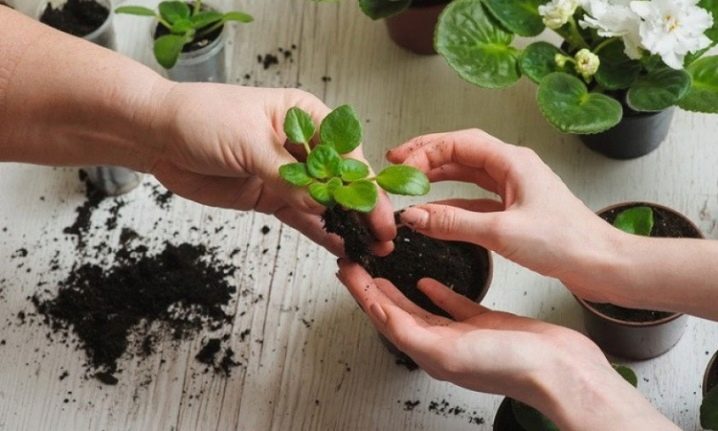
Violets are propagated by vegetative methods: seeds or cuttings. The seed method is very long and troublesome, therefore, as a rule, only breeders use it to create new varieties. At home, it is better to use cuttings. For this, a sheet is cut off with a sharp knife at a distance of 2.5-3.5 cm from the sheet plate. After that, the cuttings are placed in a vessel with water and placed in a bright, warm place.
Before the roots appear, you need to create conditions close to those of a greenhouse.To do this, cover the container with a plastic cup or plastic bag. As a rule, after 2-3 weeks, you can already see the first roots.
After that, the cutting is very carefully transplanted into the soil mixture (it can be purchased at any specialized store). The planted sprouts need solid support, so they are additionally propped up with small sticks
As soon as a young growth of about 4-5 cm in length is formed, you can cut off the mother leaf - your violet has taken root and started growing.

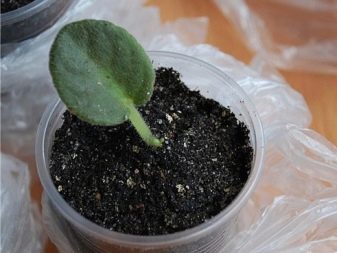
You will learn how to transplant an adult violet from the video below.
Isadora (violet): features of care
Violet is one of the most common indoor flowers. The plant with flowers of amazing shape and outlandish color is finding more and more fans. Violet flowers with five petals are collected in a brush. The leaves are fleshy, round and fluffy - covered with villi. The leaves are different in shape - pointed or rounded. The stem of the violet is shortened. The fruit is a box with small seeds.
Currently, there are several hundred varieties of violets. “Violet fashion” keeps up with the times, and every year breeders spoil florists with new species. The classics, of course, pleases with bright colors. But each new variety evokes a special thrill in the soul.
Violets Isadora relatively recently "honored" flower growers with their attention, but have already won the hearts of many of them. And for good reason
Large double and semi-double flowers, fringed along the edge with bright lilac strokes and crimson specks.
The variety pleases with abundant flowering for a long time.
Despite the fact that Isadora is an unpretentious violet, caring for her has some peculiarities. By observing them, you can grow a healthy and beautiful flower.
Soil and capacity
Violet prefers a nutritious and loose soil, permeable to air and moisture. The violet does not tolerate excess moisture, and stagnant water can lead to plant disease. Given this fact, pour drainage into the pot - a layer of pebbles or expanded clay. The most suitable soil for a plant is a mixture:
- 5 parts - leafy ground;
- 1 part - sand;
- 3 parts - peat.
Additionally, charcoal and moss (sphagnum) can be added to the soil, light soil will contribute to the development of the plant, since Isadora is a violet responsive to good care.
The roots are located in the upper layer of the soil, so a low container with a diameter of 6-9 cm is suitable for a flower. In a smaller pot, the roots will be cramped, and the plant will not develop well.
And frequent transplants hinder the good development and growth of the flower.
Temperature and humidity
The optimum temperature for violets is 20-24 degrees. In such conditions, the plants bloom for a long time, large flowers stay on the peduncle for a long time. Violet is a resistant plant that can withstand temperatures as low as 5 degrees
It is important to remember that in summer you need to avoid temperatures over 30 degrees for longer than 5 days. And in winter - at low temperatures - it is necessary to reduce watering
Isadora is a violet, for which drying out of air is destructive. It must be systematically sprayed. But it should be remembered that high humidity also leads to the development of fungal diseases.
Violet Le Isadora. Description and features of watering
It is important to water the violet correctly and do not forget that excess moisture can destroy the plant. Therefore, the flower should be watered as the soil dries.
Use warm water, as the plant simply will not tolerate cold watering.
It is recommended to settle water from the tap for 2-3 days or pass it through a filter. The violet requires careful watering, for this you need to follow the rule: water should not get to the point of growth of the flower, that is, to the center of the plant.
Therefore, watering can be done in 3 ways:
- Through the pallet - pour into it exactly as much water as the soil will absorb. Drain off the excess 30 minutes after watering.
- Watering from above is the most common and convenient way, but with a violet, it requires accuracy. Pour water in a thin stream using a watering can or a container with a straw, without getting on the leaves of the plants.
- Wick irrigation - pass a piece of cloth through the drainage hole in the container: lower one end into a container with water, the other remains on the ground surface.
Diseases and pests
Isadora is a violet that practically does not get sick, if you observe the optimal humidity in the room. Transplanting or adding new soil can lead to late blight.
You can notice it by the brown spots on the leaves. It is difficult to get rid of this disease, so superphosphate must be periodically added to the soil. The violet is susceptible to damage by nematodes and thrips.
You can get rid of pests with nematicides.


